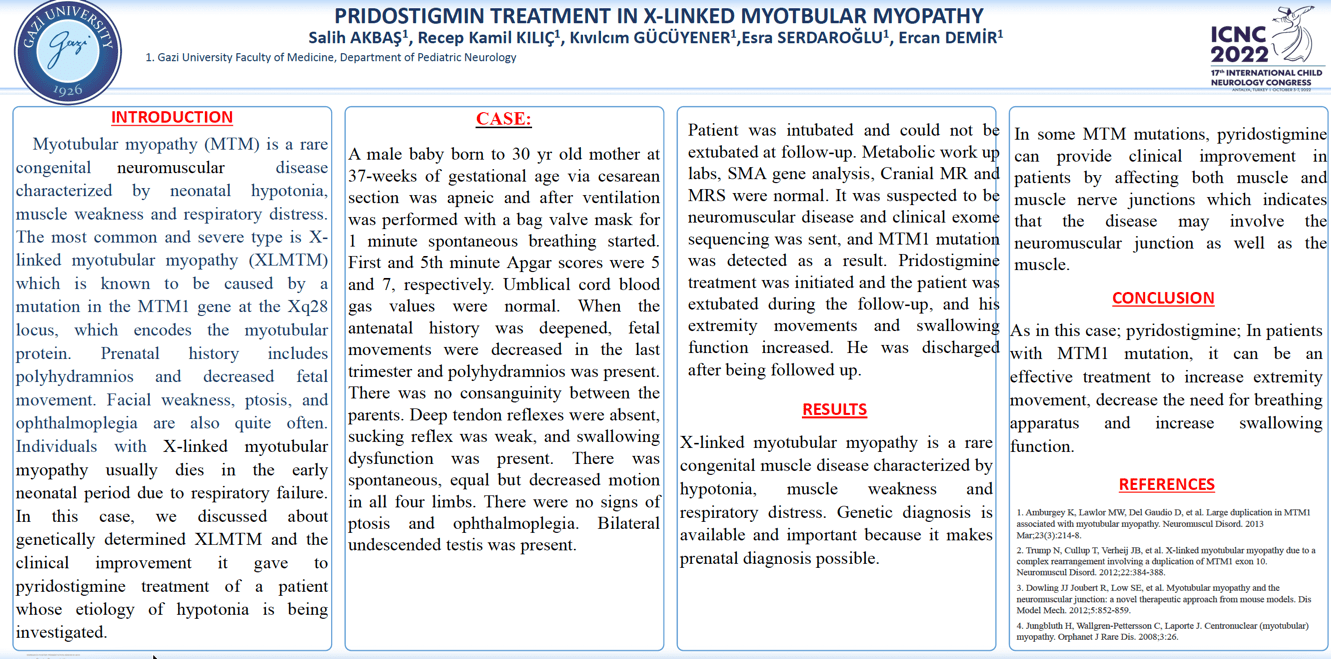PRIDOSTIGMIN TREATMENT IN X-LINKED MYOTBULAR MYOPATHY
Salih Akbaş, Recep Kamil Kilic, Kıvılcım Gücüyener, Esra Serdaroğlu, Ercan Demir
INTRODUCTION: Myotubular myopathy (MTM) is a rare congenital neuromuscular disease characterized by neonatal hypotonia, muscle weakness and respiratory distress. In this case, we discussed about genetically determined XLMTM and the clinical improvement it gave to pyridostigmine treatment of a patient whose etiology of hypotonia is being investigated. CASE: A male baby born at 37-weeks of gestational age via C/S was apneic and after ventilation was performed with a bag valve mask for 1 minute spontaneous breathing started. Fetal movements were decreased in the last trimester and polyhydramnios was present. Deep tendon reflexes were absent, sucking reflex was weak, and swallowing dysfunction was present. There was spontaneous, equal but decreased motion in all four limbs. There were no signs of ptosis and ophthalmoplegia. Bilateral undescended testis was present.Patient was intubated and could not be extubated at follow-up. It was suspected to be neuromuscular disease and clinical exome sequencing was sent, and MTM1 mutation was detected as a result. Pridostigmine treatment was initiated and the patient was extubated during the follow-up, and his extremity movements and swallowing function increased. He was discharged after being followed up. RESULTS: In some MTM mutations, pyridostigmine can provide clinical improvement in patients by affecting both muscle and muscle nerve junctions which indicates that the disease may involve the neuromuscular junction as well as the muscle. CONCLUSION: As in this case; pyridostigmine; In patients with MTM1 mutation, it can be an effective treatment to increase extremity movement, decrease the need for breathing apparatus and increase swallowing function.
Keywords: Myotubular myopathy; Pyridostigmine
Salih Akbaş
Gazi University School of Medicine
Turkey
Recep Kamil Kilic
Gazi University School of Medicine
Turkey
Kıvılcım Gücüyener
Gazi University Medical Faculty
Turkey
Esra Serdaroğlu
Gazi University Medical Faculty
Turkey
Ercan Demir
Gazi University Medical Faculty
Turkey
INTRODUCTION: Myotubular myopathy (MTM) is a rare congenital neuromuscular disease characterized by neonatal hypotonia, muscle weakness and respiratory distress. In this case, we discussed about genetically determined XLMTM and the clinical improvement it gave to pyridostigmine treatment of a patient whose etiology of hypotonia is being investigated. CASE: A male baby born at 37-weeks of gestational age via C/S was apneic and after ventilation was performed with a bag valve mask for 1 minute spontaneous breathing started. Fetal movements were decreased in the last trimester and polyhydramnios was present. Deep tendon reflexes were absent, sucking reflex was weak, and swallowing dysfunction was present. There was spontaneous, equal but decreased motion in all four limbs. There were no signs of ptosis and ophthalmoplegia. Bilateral undescended testis was present.Patient was intubated and could not be extubated at follow-up. It was suspected to be neuromuscular disease and clinical exome sequencing was sent, and MTM1 mutation was detected as a result. Pridostigmine treatment was initiated and the patient was extubated during the follow-up, and his extremity movements and swallowing function increased. He was discharged after being followed up. RESULTS: In some MTM mutations, pyridostigmine can provide clinical improvement in patients by affecting both muscle and muscle nerve junctions which indicates that the disease may involve the neuromuscular junction as well as the muscle. CONCLUSION: As in this case; pyridostigmine; In patients with MTM1 mutation, it can be an effective treatment to increase extremity movement, decrease the need for breathing apparatus and increase swallowing function.
Keywords: Myotubular myopathy; Pyridostigmine
Salih Akbaş
Gazi University School of Medicine
Turkey
Recep Kamil Kilic
Gazi University School of Medicine
Turkey
Kıvılcım Gücüyener
Gazi University Medical Faculty
Turkey
Esra Serdaroğlu
Gazi University Medical Faculty
Turkey
Ercan Demir
Gazi University Medical Faculty
Turkey

Salih Akbaş
Gazi University School of Medicine Turkey
Gazi University School of Medicine Turkey